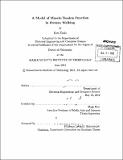| dc.contributor.advisor | Hugh Herr. | en_US |
| dc.contributor.author | Endo, Ken, Ph. D. Massachusetts Institute of Technology | en_US |
| dc.contributor.other | Massachusetts Institute of Technology. Dept. of Electrical Engineering and Computer Science. | en_US |
| dc.date.accessioned | 2012-12-13T18:47:47Z | |
| dc.date.available | 2012-12-13T18:47:47Z | |
| dc.date.copyright | 2012 | en_US |
| dc.date.issued | 2012 | en_US |
| dc.identifier.uri | http://hdl.handle.net/1721.1/75633 | |
| dc.description | Thesis (Ph. D.)--Massachusetts Institute of Technology, Dept. of Electrical Engineering and Computer Science, 2012. | en_US |
| dc.description | Cataloged from PDF version of thesis. | en_US |
| dc.description | Includes bibliographical references (p. 109-113). | en_US |
| dc.description.abstract | In order to motivate the design of legged machines that walk as humans do, this thesis investigates how leg muscles and tendons work mechanically during level-ground human walking at self-selected speeds. I hypothesize that quasi- passive, series-elastic clutch units spanning the knee joint in a musculoskeletal arrangement can capture the dominant mechanical behaviors of the human knee in level-ground walking. As a preliminary evaluation of this hypothesis, I develop an under-actuated model of the human leg in walking where each muscle-tendon unit spanning the knee joint is represented as a simple linear spring in series with a clutch. I vary model parameters, or spring constants and clutch engagement times, using an optimization scheme that minimizes ankle and hip actuator work while still maintaining human-like knee mechanics. For model evaluation, kinetic and kinematic gait data are employed from nine participants walking across a level-ground surface at self-selected gait speeds. With this under-actuated leg model, I find good agreement between model quasi-passive knee torque and experimental knee values, suggesting that a knee actuator is not necessary for level-ground robotic ambulation at self-selected gait speeds. As a further evaluation of the hypothesis of spring-like muscle-tendon behavior about the knee joint, a forward dynamics control scheme for the under-actuated model is developed. Hill-type muscle models are employed to model the ankle soleus and hip monoarticular muscles. Further, the model's series-elastic clutches are engaged with a simple state machine based on electromyography (EMG) data from the literature. Muscles are controlled with simple feedback controls representing the reflexive architecture of the human neuromuscular system. Following an optimization procedure, the model is shown to predict joint and muscle biomechanics, as well as the metabolism of walking humans, supporting the idea that muscle-tendon units spanning the human knee joint mainly operate as spring elements during neural activation, affording the relatively high metabolic walking economy of humans. | en_US |
| dc.description.statementofresponsibility | by Ken Endo. | en_US |
| dc.format.extent | 113 p. | en_US |
| dc.language.iso | eng | en_US |
| dc.publisher | Massachusetts Institute of Technology | en_US |
| dc.rights | M.I.T. theses are protected by
copyright. They may be viewed from this source for any purpose, but
reproduction or distribution in any format is prohibited without written
permission. See provided URL for inquiries about permission. | en_US |
| dc.rights.uri | http://dspace.mit.edu/handle/1721.1/7582 | en_US |
| dc.subject | Electrical Engineering and Computer Science. | en_US |
| dc.title | A model of muscle-tendon function in human walking | en_US |
| dc.type | Thesis | en_US |
| dc.description.degree | Ph.D. | en_US |
| dc.contributor.department | Massachusetts Institute of Technology. Department of Electrical Engineering and Computer Science | |
| dc.identifier.oclc | 818209216 | en_US |
